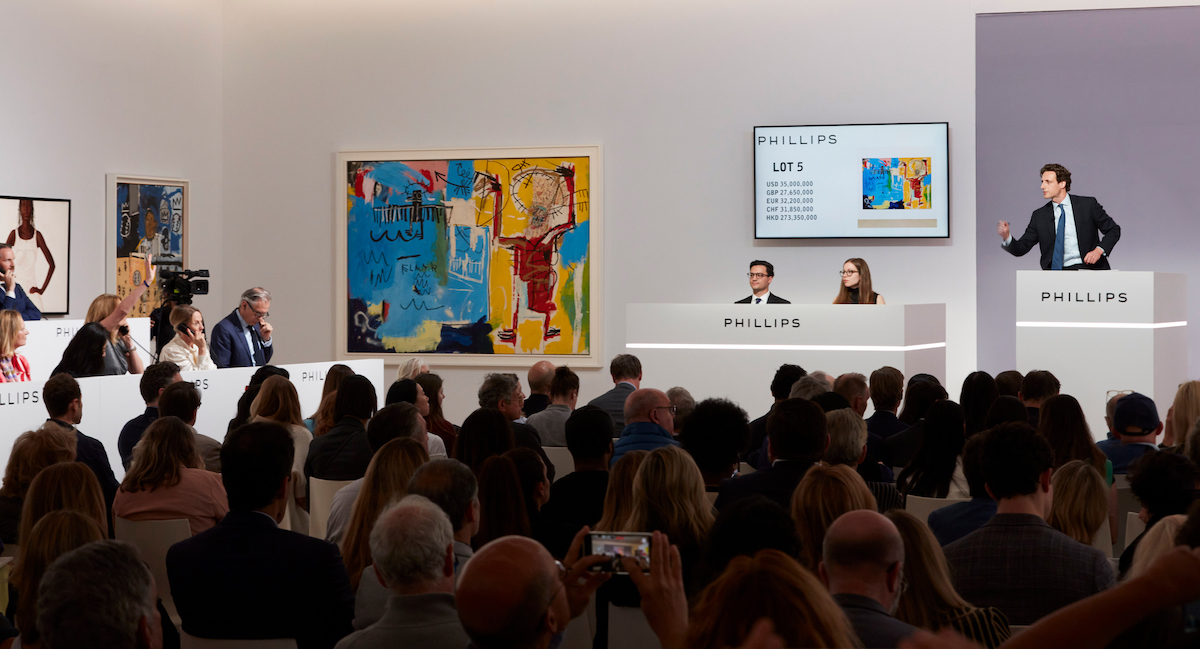
Editor’s Note: This story originally appeared in On Balance, the ARTnews newsletter about the art market and beyond. Sign up here to receive it every Wednesday.
One of the most startling things I saw happen during the first two days of art auctions in New York took place before any bids had been made.
A few minutes before Sotheby’s ultra-contemporary evening sale, “The Now,” was set to begin, a cameraman tripped over a stanchion and narrowly avoided putting an entire palm into a large, untitled work by Jean-Michel Basquiat and Andy Warhol. Several staffers were clearly shaken by the near-disaster involving this collaborative piece from 1984, which carried a low estimate of $15 million.
Thankfully, Lot 105 remained undamaged. It sold for $19.4 million, a record for a Warhol-Basquiat collaboration, and the fourth-highest amount for the night.
Even with a crisis averted, the mood throughout the first two days of sales of the New York May sales was filled with anxiety among buyers and consignors. “It didn’t feel exciting in the room,” art adviser Dane Jensen told ARTnews.
A sense of narrowly avoided disaster characterized two sales at Christie’s the following night, held after several days of the auction house’s website being down due to a “technology security issue.” The de la Cruz collection and the 21st century evening sale still managed high sell-through rates; a YouTube livestream went on as planned, and online bidding continued through Christie’s Live, the house’s online platform for remote bidding. But several art advisers told ARTnews it would be hard to know how many people were deterred from jumping in on the action, especially for an estate that was so well-known. “Even one less bidder can make a huge impact on the performance of a work,” Jensen said.
A high number of guarantees and irrevocable bids helped smooth things over and raise sell-through rates, but many lots by notable artists went for sums below their low estimates. Other lots were withdrawn, and still some others did not sell at all. At Phillips, Frank Stella’s Lettre sur les sourds et muets II (1974), from the private collection of gallerist Marianne Boesky, was estimated to sell for $5 million to $7 million. It failed to find a buyer. And despite being described by Christie’s as “considered the most important and ambitious painting” of Mark Tansey’s career, Mont Sainte-Victoire #1 (1987), estimated to sell for between $8 million–$12 million, also went unsold.
Incremental bids from several specialists in pursuit of a deal also pulled down the mood, with auctioneers like Sotheby’s European chairman Oliver Barker exclaiming, “It’s like extracting teeth, my goodness.”
As a result, several art advisers who spoke to ARTnews immediately after the start of the marquee sale week in New York also noted the unevenness of the initial results.
On Monday night, art adviser Ivy Shapiro told ARTnews that, while there were a few sales that “went through the roof,” for the most part, Sotheby’s was subdued. “It’s cautious, but it’s steady. And if people want something, they want it.”
Jensen said the spectacle of art auctions can blind people to noticing how long things haven’t been doing well in different areas of the art market, such as flat demand for established postwar artists. It’s commonly thought that artists’ prices rise once they die, but this isn’t always the case, as evidenced by Stella, who passed away on May 4. Ifafa I, a significant 1964 shaped canvas by him, came to auction at Sotheby’s with a $14 million low estimate and hammered only just a little above that. “It may be that there isn’t a reason” the painting didn’t sell, Jensen told ARTnews. “It’s just because the market has gone down.”
There were still bright spots, especially for painting and sculptures by artists of color, queer artists, and women. At Christie’s, records were set for Ana Mendieta (twice over in the same sale), Felix Gonzalez-Torres, Reggie Burrows Hodges, and Diane Arbus. At Phillips, Kent Monkman tripled his record, bringing it to $381,000, for the 2020 painting The Storm. And at Sotheby’s, new records were established for Faith Ringgold, Justin Caguiat, and Lucy Bull, whose works all sold for more than $1 million.
Sotheby’s extensive contemporary day sale on May 14 also saw several paintings far exceed their high estimates: Emmi Whitehorse’s #534 Untitled for $127,000 on an estimate of $15,000 to $20,000; Alex Katz’s May for $1.88 million on an estimate of $500,000 to $700,000; Salvo’s Senza Titolo for $406,400 on an estimate of $40,000 to $60,000; Olga de Amaral’s Pueblo X for $698,500 on an estimate of $250,000 to $350,000; and Antonio Obá’s Sankofa – Figura Com Alpargata for $228,600 on an estimate of $60,000 to $80,000. The works by Whitehorse and Salvo both did not have guarantees or irrevocable bids, and they sold for more than six times their high estimates.
One of the most astute comments on the wobbly state of the art market came just as the week of sales was about to start. On the Nota Bene podcast, recorded last week and aired on Sunday, dealer Lock Kresler observed that we are seeing a very different scenario today than in the wake of the 2008 recession, when the art market made a pretty speedy recovery. “We haven’t seen a crash,” he said, “but we also haven’t seen anything resembling a window out.”
